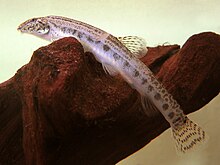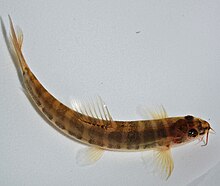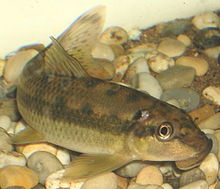Cypriniformes
| Cypriniformes Temporal range:
| |
|---|---|

| |
| A wild-type common carp (Cyprinus carpio, Cyprinidae: Cyprininae )
| |
| Scientific classification | |
| Domain: | Eukaryota |
| Kingdom: | Animalia |
| Phylum: | Chordata |
| Class: | Actinopterygii |
| (unranked): | Otophysi
|
| (unranked): | Cypriniphysae
|
| Order: | Cypriniformes Bleeker, 1859 |
| Type species | |
| Families[4] | |
|
Acheilognathidae[1] Balitoridae Barbuccidae[2] Botiidae[2] Catostomidae Cobitidae Cyprinidae Danionidae[1] Ellopostomatidae[2] Gastromyzontidae[2] Gobionidae[1] Gyrinocheilidae † Jianghanichthyidae[3] Leptobarbidae[1] Leuciscidae[1] Nemacheilidae Paedocyprididae[1] Psilorhynchidae Serpenticobitidae[2] Sundadanionidae[1] Tanichthyidae[1] Tincidae[1] Vaillantellidae[2] Xenocyprididae[1] and see text | |
| Diversity | |
| Around 4,205 species | |
Cypriniformes
Their closest living relatives are the
Description
Like other orders of the

The most notable family placed here is the
The
Systematics


Historically, these included all the forms now placed in the
The
The mountain carps are the highly apomorphic Cyprinidae, perhaps close to true carps (Cyprininae), or maybe to the danionins. While some details about the phylogenetic structures of this massively diverse family are known – e.g. that Cultrinae and Leuciscinae are rather close relatives and stand apart from Cyprininae – no good consensus exists yet on how the main lineages are interrelated. A systematic list, from the most ancient to the most modern lineages, can thus be given as:[1]
- Family †
- Suborder Cyprinoidei
- Family AcheilognathidaeBleeker, 1863
- Family Cyprinidae Rafinesque, 1815 (carps, koi, goldfish) and minnows
- Family DanionidaeBleeker, 1863
- Family GobionidaeBleeker, 1863
- Family LeptobarbidaeBleeker, 1864
- Family LeuciscidaeBonaparte, 1853
- Family PaedocyprididaeMayden & Chen, 2010
- Family Psilorhynchidae Hora, 1926
- Family SundadanionidaeMayden & Chen, 2010
- Family TanichthyidaeMayden & Chen, 2010
- Family TincidaeJordan, 1878
- Family XenocyprididaeGünther, 1868
- Family
- Suborder Catostomoidei
- Family Catostomidae Agassiz 1850 (suckers)
- Suborder Gyrinocheiloidei
- Family GyrinocheilidaeGill 1905 (algae eaters; sucking loaches)
- Family
- Suborder Cobitoidei
- Family BalitoridaeSwainson 1839 (hillstream loaches)
- Family BarbuccidaeKottelat 2012 (scooter/fire-eyed loaches)
- Family Botiidae Berg 1940 (pointface loaches)
- Family Cobitidae Swainson 1838 (true loaches)
- Family EllopostomatidaeBohlen & Šlechtová 2009 (square-head/sturgeon-mouthed loaches)
- Family Gastromyzontidae Fowler 1905 (sucker loaches)
- Family Nemacheilidae Regan 1911 (brook/stone loaches)
- Family SerpenticobitidaeKottelat 2012 (snake/serpent loaches)
- Family VaillantellidaeNalbant & Bănărescu 1977 (longfin loaches)
- Family
Phylogeny
Phylogeny based on the work of the following works[16][17][18][19][20]
| Cypriniformes |
| |||||||||||||||||||||||||||||||||||||||||||||||||||||||||
Evolution
Cypriniformes include the most primitive of the Ostariophysi in the narrow sense (i.e. excluding the
The Cypriniformes are thought to have originated in
The earliest cypriniform fossils are already assignable to the living
Relationship with humans
The Cyprinidae in particular are important in a variety of ways. Many species are important food fish, particularly in Europe and Asia. Some are also important as aquarium fish, of which the goldfish and koi are perhaps the most celebrated. The other families are of less commercial importance. The Catostomidae have some importance in angling, and some "loaches" are bred for the international aquarium fish trade.
Accidentally or deliberately introduced populations of
In science, one of the most famous members of the Cypriniformes is the zebrafish (Danio rerio). The zebrafish is one of the most important vertebrate model organisms in biological and biochemical sciences, being used in many kinds of experiments. During early development, the zebrafish has a nearly transparent body, so it is ideal for studying developmental biology. It is also used for the elucidation of biochemical signaling pathways.[26] They are also good pets, but can be shy in bright light and crowded tanks.
Threats and extinction

The well-known
Globally extinct Cypriniformes species are:[27]
- Acanthobrama hulensis
- Gökçe balığı, Alburnus akili
- Barbus microbarbis
- Snake River sucker, Chasmistes muriei
- Chondrostoma scodrense
- Cyprinus yilongensis
- Mexican dace, Evarra bustamantei
- Plateau chub, Evarra eigenmanni
- Endorheic chub, Evarra tlahuacensis
- Thicktail chub, Gila crassicauda
- Pahranagat spinedace, Lepidomeda altivelis
- Harelip sucker, Moxostoma lacerum
- Durango shiner, Notropis aulidion
- Phantom shiner, Notropis orca
- Salado shiner, Notropis saladonis
- Clear Lake splittail, Pogonichthys ciscoides
- Las Vegas dace, Rhinichthys deaconi
- Stumptooth minnow, Stypodon signifer
- Telestes ukliva
Notes
- ^ a b c d e f g h i j k Tan & Armbruster (2018)
- ^ a b c d e f g Kottelat, M. (2012)
- ^ ISSN 0272-4634.
- ^ a b Froese, Rainer, and Daniel Pauly, eds. (2012). "Cypriniformes" in FishBase. December 2012 version.
- S2CID 52976511.
- ^ Eschmeyer, W.N., Fong, J.D. (2015) Species by family/subfamily in the Catalog of Fishes, California Academy of Sciences (retrieved 2 July 2015)
- ^ a b c d Nelson (2006)
- PMID 31149641.
- ^ Saitoh et al. (2003), Briggs (2005)
- ^ Orlov & Sa-a {2007]
- ^ FishBase (2004d,f), He et al. (2008)
- ^ FishBase (2004a,e)
- ^ FishBase (2004b,c)
- ^ a b He et al. (2008)
- ^ Helfman et al. (1997): pp.228-229
- PMID 17433724.
- PMID 20738682.
- ^ Jörg Bohlen, Vendula Šlechtová: Phylogenetic position of the fish genus Ellopostoma (Teleostei: Cypriniformes) using molecular genetic data. Ichthyological Exploration of Freshwaters. Bd. 20, Nr. 2, 2009, S. 157-162 (PDF Archived 24 September 2015 at the Wayback Machine; 1,8 MB)
- ^ Mikko Haaramo. "Cobitoidei – loach-like cypriniforms". Mikko's Phylogeny Archive. Retrieved 26 October 2013.
- ^ "ITIS Standard Report Page: Cyprinoidea". www.itis.gov. Retrieved 26 July 2019.
- ^ Saitoh et al. (2003)
- ^ Briggs (2005), Nelson (2006)
- ^ a b Briggs (2005)
- ISSN 0272-4634.
- ^ GSMFC (2005), FFWCC [2008]
- ^ "Biochemical Signaling Pathways". ZFIN.
- ^ a b IUCN (2007)
References
- Briggs, John C. (2005): The biogeography of otophysan fishes (Ostariophysi: Otophysi): a new appraisal. (HTML abstract)
- FishBase (2004a): Family Balitoridae - River loaches. Version of 2004-NOV-22. Retrieved 2007-03-05.
- FishBase (2004b): Family Catostomidae - Suckers. Version of 2004-NOV-22. Retrieved 2007-03-05.
- FishBase (2004c): Family Cobitidae - Loaches. Version of 2004-NOV-22. Retrieved 2007-03-05.
- FishBase (2004d): Family Cyprinidae - Minnows or carps. Version of 2004-NOV-22. Retrieved 2007-03-05.
- FishBase (2004e): Family Gyrinocheilidae - Algae eaters. Version of 2004-NOV-22. Retrieved 2007-03-05.
- FishBase (2004f): Family Psilorhynchidae - Mountain carps. Version of 2004-NOV-22. Retrieved 2007-03-05.
- FishBase (2005): Order Summary for Cypriniformes. Version of 2005-FEB-15. Retrieved 2007-03-05.
- Florida Fish and Wildlife Conservation Commission (FFWCC) (2006): Florida's Exotic Freshwater Fishes. Retrieved 2007-03-05.
- Gulf States Marine Fisheries Commission (GSMFC) (2005): Cyprinus carpio (Linnaeus, 1758). Version of 2005-08-03. Retrieved 2007-05-03.
- He, Shunping; Gub, Xun; Mayden, Richard L.; Chen, Wei-Jen; Conway, Kevin W. & Chen, Yiyu (2008): Phylogenetic position of the enigmatic genus Psilorhynchus (Ostariophysi: Cypriniformes): Evidence from the mitochondrial genome. (HTML abstract)
- Helfman, G.; Collette, B. & Facey, D. (1997): The Diversity of Fishes. Blackwell Publishing. ISBN 0-86542-256-7
- International Union for Conservation of Nature (IUCN) (2007): [www.iucnredlist.org 2007 IUCN Red List of Threatened Species].
- Kottelat, M. (2012): Conspectus cobitidum: an inventory of the loaches of the world (Teleostei: Cypriniformes: Cobitoidei). The Raffles Bulletin of Zoology, Suppl. No. 26: 1-199.
- Nelson, Joseph S. (2006): ISBN 0-471-25031-7
- Orlov, Alexei & Sa-a, Pascualita [2007]: FishBase - Tribolodon brandtii. Retrieved 2007-03-05.
- Saitoh, Kenji; Miya, Masaki; Inoue, Jun G.; Ishiguro, Naoya B. & Nishida, Mutsuminame (2003): Mitochondrial Genomics of Ostariophysan Fishes: Perspectives on Phylogeny and Biogeography. PMID 12664166(HTML abstract)
- Tan, Milton & Armbruster, Jonathan W. (2018): Phylogenetic classification of extant genera of fishes of the order Cypriniformes (Teleostei: Ostariophysi). (HTML abstract)
